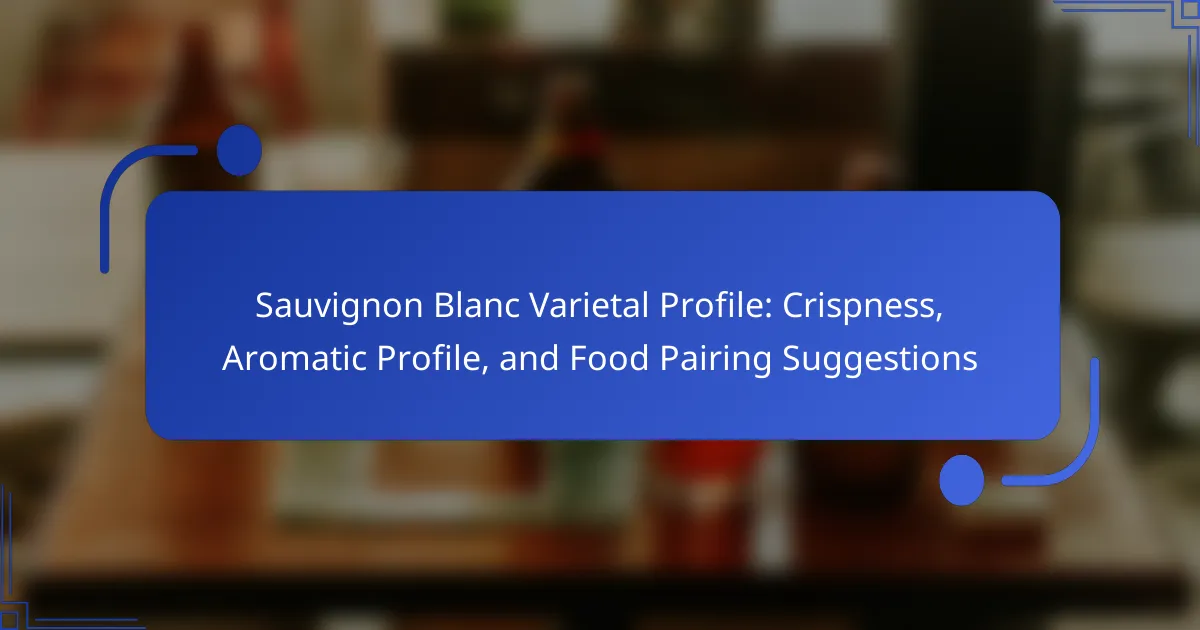
What is the Sauvignon Blanc varietal profile?
Sauvignon Blanc is a white grape variety known for its vibrant acidity and aromatic profile. It typically exhibits notes of citrus, green apple, and tropical fruits. The varietal is often characterized by herbaceous qualities, such as bell pepper and freshly cut grass. Sauvignon Blanc wines can range from dry to sweet, with a crisp and refreshing finish. The grape thrives in various regions, including France’s Loire Valley and New Zealand. Its high acidity makes it an excellent choice for food pairings, particularly with seafood and salads. These attributes contribute to its popularity among wine enthusiasts.
How does the crispness of Sauvignon Blanc influence its taste?
Crispness in Sauvignon Blanc significantly enhances its taste. This crispness contributes to a refreshing acidity. The acidity balances the wine’s fruit flavors, making them more vibrant. It also adds a clean finish to each sip. This characteristic is often described as zesty or bright. Crisp Sauvignon Blancs typically exhibit citrus notes like lime and grapefruit. These flavors are intensified by the wine’s acidity. Research has shown that wines with higher acidity are perceived as more refreshing. Thus, the crispness of Sauvignon Blanc is crucial for its overall appeal.
What are the key characteristics that define the crispness of Sauvignon Blanc?
Crispness in Sauvignon Blanc is defined by high acidity and vibrant fruit flavors. The wine typically exhibits a zesty profile, often characterized by notes of citrus and green apple. This acidity contributes to a refreshing mouthfeel. The cool climate where Sauvignon Blanc is grown enhances its crisp quality. Regions like Marlborough in New Zealand are known for producing particularly crisp examples. Additionally, the winemaking process can accentuate crispness through techniques like stainless steel fermentation. The result is a clean, bright finish that is highly regarded in this varietal.
How does climate affect the crispness of Sauvignon Blanc wines?
Climate significantly affects the crispness of Sauvignon Blanc wines. Cooler climates typically enhance the wine’s acidity. This acidity contributes to the perception of crispness. Regions like Marlborough in New Zealand produce vibrant, crisp Sauvignon Blanc due to cooler temperatures. In contrast, warmer climates can lead to lower acidity levels. This results in a rounder mouthfeel and less crispness. For example, Sauvignon Blanc from warmer areas like California may taste fruitier and less sharp. The balance of sugar and acidity is crucial for defining crispness. Thus, climate plays a vital role in shaping the overall profile of Sauvignon Blanc wines.
What is the aromatic profile of Sauvignon Blanc?
Sauvignon Blanc has a distinctive aromatic profile characterized by high acidity and vibrant fruit notes. Common aromas include citrus fruits like lime and grapefruit. It often features green notes such as bell pepper and freshly cut grass. Additionally, tropical fruit scents like passion fruit and kiwi may be present. Some variations exhibit herbal qualities, including hints of basil and thyme. The aromatic complexity can also include mineral undertones, reflecting the terroir. This profile contributes to its popularity in various wine regions, particularly in New Zealand and France.
What are the primary aromas associated with Sauvignon Blanc?
The primary aromas associated with Sauvignon Blanc include citrus, green apple, and tropical fruits. Citrus notes often feature grapefruit and lime. Green apple provides a crispness that enhances freshness. Tropical fruit aromas can include passion fruit and pineapple. Additionally, herbal notes such as bell pepper and freshly cut grass are also common. These aromas contribute to the wine’s distinctive profile. Studies show that these characteristics are consistent across various regions where Sauvignon Blanc is produced.
How do different regions influence the aromatic profile of Sauvignon Blanc?
Different regions significantly influence the aromatic profile of Sauvignon Blanc. In cooler climates, such as the Loire Valley in France, Sauvignon Blanc typically exhibits high acidity and pronounced citrus notes. These wines often showcase aromas of lime, green apple, and flint.
Conversely, warmer regions like California produce Sauvignon Blanc with riper fruit characteristics. These wines can display aromas of peach, melon, and tropical fruits. The terroir, including soil composition and climate, directly impacts the grape’s expression.
For example, Marlborough in New Zealand is renowned for its distinct Sauvignon Blanc. It often features vibrant notes of passionfruit and gooseberry, attributed to the region’s unique growing conditions.
Overall, the interplay of climate, soil, and winemaking techniques across regions shapes the diverse aromatic profiles of Sauvignon Blanc.
What food pairings complement Sauvignon Blanc?
Sauvignon Blanc pairs well with a variety of foods. Seafood dishes, especially shellfish, enhance its crisp acidity. Grilled vegetables complement its herbal notes. Goat cheese is a classic pairing, as its tanginess balances the wine’s flavor profile. Light salads with citrus dressings also work well. Dishes featuring green herbs, like pesto, can highlight Sauvignon Blanc’s aromatic qualities. These pairings are supported by its bright acidity and fresh fruit flavors, which enhance the overall dining experience.
What types of dishes pair best with Sauvignon Blanc?
Sauvignon Blanc pairs best with seafood, salads, and light poultry dishes. The wine’s crisp acidity complements the freshness of seafood like oysters and shrimp. It enhances the flavors of green salads, especially those with citrus dressings. Lightly grilled chicken or turkey also works well, as the wine’s herbal notes harmonize with the meat. Additionally, dishes featuring goat cheese are a classic pairing due to the wine’s acidity balancing the cheese’s richness. These pairings are supported by wine experts who note the importance of acidity in food and wine compatibility.
How does the wine’s crispness affect its food pairing versatility?
The crispness of wine significantly enhances its food pairing versatility. Crisp wines, like Sauvignon Blanc, have high acidity, which complements a wide range of dishes. This acidity cuts through rich flavors, balancing fatty foods such as cheese and creamy sauces. Additionally, the refreshing quality of crisp wines enhances lighter fare, including salads and seafood. Studies show that wines with higher acidity are more adaptable in pairing with diverse cuisines. For instance, Sauvignon Blanc’s crispness allows it to pair well with both spicy Asian dishes and herbaceous Mediterranean meals. This versatility is largely due to its ability to cleanse the palate, making each bite more enjoyable.
How can one enhance their tasting experience of Sauvignon Blanc?
To enhance the tasting experience of Sauvignon Blanc, serve it chilled at 45-50°F. This temperature accentuates its crispness and aromatic profile. Use a tulip-shaped glass to concentrate the aromas. Swirling the wine releases more fragrance, enhancing the sensory experience. Pair Sauvignon Blanc with complementary foods like fresh seafood or goat cheese. The wine’s acidity balances rich flavors, elevating the overall tasting experience. Notably, studies show that wine temperature significantly affects flavor perception. Proper serving techniques can improve enjoyment and appreciation of Sauvignon Blanc.
What tips should one consider when selecting Sauvignon Blanc for a meal?
When selecting Sauvignon Blanc for a meal, consider the wine’s acidity and flavor profile. Sauvignon Blanc typically has high acidity, which complements rich foods. Look for citrus and green herb notes, as these pair well with lighter dishes. Match the wine’s intensity to the meal, opting for more robust flavors with fuller-bodied options. Consider the region; New Zealand Sauvignon Blanc is known for its vibrant fruitiness. Serve it chilled to enhance its crispness. Always taste the wine before serving to ensure it aligns with the meal’s flavors. These tips help create a balanced dining experience.
Sauvignon Blanc is a white grape variety recognized for its vibrant acidity and distinctive aromatic profile, featuring notes of citrus, green apple, and herbal qualities. The article explores the key characteristics that define the crispness of Sauvignon Blanc, including the impact of climate and winemaking techniques on its taste and aroma. It also examines food pairings that complement this varietal, highlighting its versatility with seafood, salads, and cheese. Additionally, tips for enhancing the tasting experience and selecting the right Sauvignon Blanc for meals are provided, ensuring a comprehensive understanding of this popular wine.
